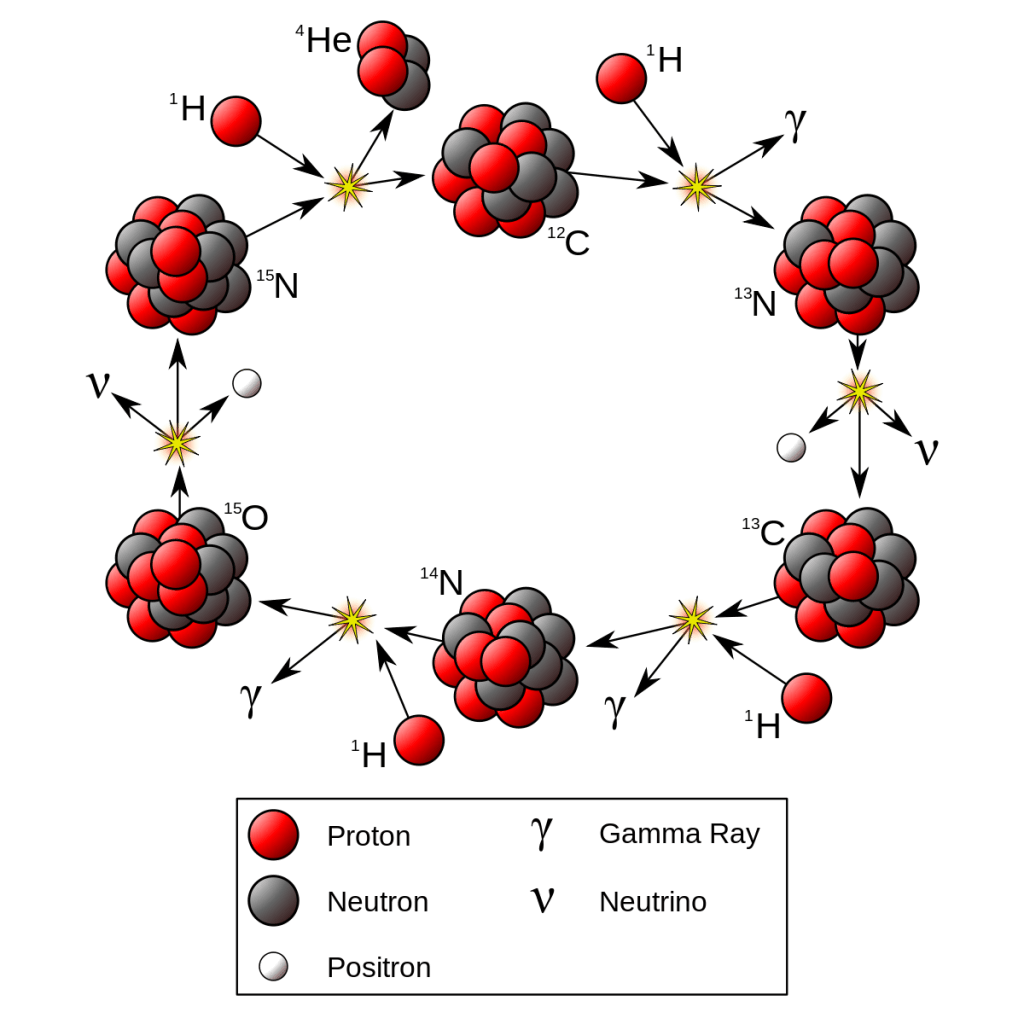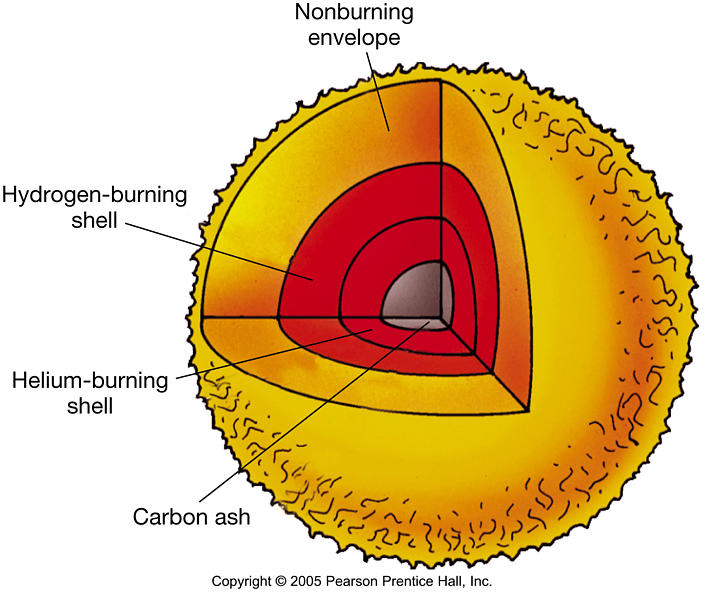
When people think of star death, they most often think of supernovae (plural for supernova). So why haven’t I spent the past bunch of posts on star death talking about them?
Because supernovae are not actually the most common fate to await a star. Only a small fraction of the stars in our universe are massive enough to go supernova. Most stars die fairly quietly, gently expelling their outer layers and contracting to form white dwarfs.
No such gentle fate awaits the most massive stars.
But why do massive stars go supernova?
There is one key difference between massive stars and their medium- and low-mass siblings: they can fuse elements heavier than helium.
Helium fusion is the end of the line for a medium-mass star (and a low-mass star never gets that far). These lower mass stars end up as tiny, faint compact objects known as white dwarfs, which are balls of inert carbon and oxygen the size of Earth.
Massive stars, however, don’t have many of their siblings’ limitations. For example, their cores never become degenerate, and they never experience the helium flash. All the crazy-weird things from the quantum mechanical world that happen to medium-mass stars don’t happen to them.
So, let’s devote some time to following these massive, violent cosmic objects through their lifespan.

We begin with the CNO cycle, an extremely efficient nuclear reaction whose end goal is to fuse hydrogen into helium.
Only massive stars have a high enough internal pressure to smash carbon, oxygen, and nitrogen nuclei together and get energy out of it. Most stars just use the proton-proton chain, a much simpler reaction that yields less energy.
The thing is, massive stars have to use the CNO cycle. The proton-proton chain doesn’t produce enough energy to sustain their incredible mass against the force of their own gravity.
When they run out of hydrogen nuclei in their cores, they can go straight to helium fusion—like I mentioned above, there’s no step for degeneracy or the helium flash. They’re hot enough to immediately ignite helium fusion.
At that point, things proceed similarly to how a medium-mass star would evolve.

The helium-fusing core acts like a stovetop, igniting the unused hydrogen fuel just around it. A hydrogen-fusing “shell” burns outward through the star like a brushfire.
Hydrogen fusion can last 3 million years, 88% of a massive star’s lifetime. But helium fusion can only last around 400,000 years. Why?
The main problem is that with each new fuel, the star runs out of nuclei to fuse. Hydrogen fusion fuses two protons (hydrogen nuclei) into just one helium nucleus. So there’s only half as much helium in the core as there was hydrogen—half the fuel.
But 400,000 isn’t half of 3 million. What else gets in the way?
Well, fusing heavier nuclei yields less energy than fusing lighter nuclei. Helium nuclei are twice the weight of hydrogen nuclei, so fusing them doesn’t yield as much energy and the star actually has to go through its limited helium supply even faster to support its incredible weight.
Next up is carbon fusion, with no pause for breath. The star gets its carbon fuel from the “ashes” that helium fusion dumps into the center of the core.

As carbon fusion begins, it again acts like a stovetop, igniting a layer of helium fusion just outside the core. Now two “shells” of nuclear fusion burn outward through the star.
Because carbon is heavier than helium and because there’s less than half as much of it, carbon fusion only lasts for about 600 years. Next up is neon, the ashes of carbon fusion. After that comes oxygen fusion, and last but not least—within only half a year—silicon fusion.
Keep in mind that with each new fuel fusing in the core, a shell of the previous fuel burns outward behind the hydrogen and helium shells. In only a day, a silicon-fusing shell burns outward, with iron ashes left in the core.

The iron core is a dead end.
But not because the star isn’t hot enough to fuse it. If it could, it would—massive stars are just that hot. No, the iron core is a dead end because iron fusion doesn’t produce energy.
There are two types of nuclear reactions: fission and fusion. Fission is the splitting of atomic nuclei; fusion is, well, the fusing of them (sticking them together). Heavy nuclei like uranium and other familiar nuclear fuels do not produce energy through fusion. The only way to get energy is by splitting those nuclei—fission.
Stars use light nuclei for fuel, so they engage in fusion. Hydrogen, helium, carbon, and the rest must be fused to generate energy. But iron is special. It’s neither a heavy element nor a light element. Split it or fuse it; no energy will be produced either way.

The curve on this graph progresses from left to right as elements become heavier. I’m not sure how well you can see it, but the line down the middle is right on Fe, the element symbol for iron.
So…what happens to the iron core?
Well, long story short, this is the moment you’ve all been waiting for.
As the shells burn outward, they leave their ashes behind for each subsequent shell to fuse, until the silicon shell dumps more iron into the core…and more, and more. Eventually, the iron core reaches the Chandrasekhar limit of about 1.4 solar masses (M☉), and it must collapse.
But the core isn’t alone. Imagine if you were standing on top of a tower and the foundation collapsed. Do you think the tower would stay standing?
Exactly why the rest of the star has to collapse along with the core. But here’s the problem. All that matter falling into the same central spot creates a sort of “traffic jam,” as if all the residents of a region suddenly decided to drive to the capital as fast as they could.
And it doesn’t stop there.

Imagine you’re driving one of the cars in this image, trying to get to your capital city. The traffic jam might start at the city itself, but as more cars pack themselves in, it’ll spread outward into the surrounding roads.
In a star, this becomes a shockwave—but it’s not the cause of a supernova.
Quite a twist, huh?
That’s because the shockwave stalls within a few thousandths of a second. But there’s another mechanic at work…
Let’s not forget that in-falling material generates thermal energy. Most of this energy—about 99%—is in the form of neutrinos, subatomic particles that rarely ever interact with normal matter. The core of a supergiant in collapse is so dense it’s nearly opaque to neutrinos, though. Which is pretty crazy.
The result? Neutrinos actually get absorbed by the gas of the core, which absorbs some of the energy and lets the core collapse even faster. Those neutrinos that get through the core push on the star’s still-dense outer layers…but that still isn’t enough.
I don’t know about you, but I had no idea stars were so hard to explode.
What finally does the trick is actually convection, driven by in-falling material bouncing off the ultra-dense core. This gives the stalled shockwave an outward boost, along with some other effects of the star’s magnetic field and rotation that aren’t quite understood.

From here on, it only takes a matter of hours for the shockwave to push out through the star—pretty impressive, given that the supergiants we’re talking about can be around 500 times the size of our own sun. The star is blasted apart in the famed supernova explosion.
There are still a lot of unanswered questions as far as supernovae are concerned. The processes that drive them aren’t fully understood, and this is because they are very rare. They occur within a matter of hours, so the chances of catching one even if they occurred frequently are slim. They also only occur for massive stars, which are very rare.
There are plenty of supernova remnants visible in our night sky—clouds of hot gas that are the exploded remains of the star—but supernovae in progress have generally only been observed in other galaxies. That’s just how rare they are.
For the next two posts, we’ll explore supernovae—the different types, as well as case studies of some that have occurred in the past.